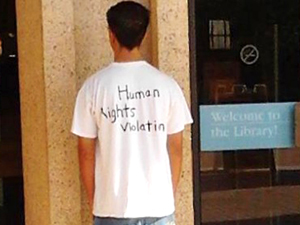
>>CLARIFICATION: If plain clothes police officers were used for any police investigation, it would be at discretion of the chief of police and depend on factors unique to such situations.
CSUN had its emergency confidence tested a year ago today when police were alerted to a possible gunman on campus that led to a search that lasted over eight hours, before the suspect turned himself in shortly after 8:00 p.m.
The suspect, identified as CSUN student Gahren Moradian, initially captured the attention of students as he stood outside the library and faced a wall in apparent protest, wearing a t-shirt with “human rights violatin” (sic) scribbled on it.
Moradian proceeded to enter the library, and told an employee he had a gun. When CSUN police were notified, the library was evacuated using the fire drill system and subsequently searched by police, four K-9 units and a bomb squad.
He has since been convicted of disturbance of peace of school, California Penal Code Section 415.5, on Jan. 26, according Los Angeles Superior Court records.
Moradian was also facing a felony criminal threats charge, but was dismissed.
Emergency procedures for CSUN are in compliance with state laws and federal laws, but whether or not students and faculty are familiar with or could execute emergency plans is more ambiguous.
Amid the uncertainty as to the suspect’s whereabouts, business on campus continued as usual that day, but the sentiment of disorder lingered as the campus held its breath for news about the suspect.
Martha Silva, 19, a sophomore at CSUN studying psychology, returned to her dormitory after classes but recalls the tone of the campus that day.
“At the dorms, no one came and told us anything. We all knew what was happening, but no one in authority told us anything. We just went about our day,” Silva said.
CSUN was recently on high alert again on Sept. 12 after an unsubstantiated claim that there was a person with a gun on campus was reported to CSUN Police Department.
After issuing a warning to students and faculty, CSUN PD officers conducted a search of the campus for the suspected person, according to a past Sundial article.
An all clear message was later sent out stating that CSUN PD had not found any suspects or threats.
An enduring question following both suspected gunman incidents was whether or not the student body was promptly notified.
During last year’s gunman incident, CSUN PD was notified at 10:27 a.m., but email notifications were not sent out to students until 11:45 a.m.
During this year’s gunman scare CSUN PD was notified at 12:25 p.m. and notification emails were sent out at 1:10 p.m. Response time improved by 33 minutes.
CSUN provides its faculty with a “Responding to Disruptive or Threatening Student Behavior: A Guide for Faculty” manual, which details how to respond to potentially violent students.
The manual instructs faculty to give the student a warning, involve others, seek voluntary course withdrawal, or if immediate action is necessary, to remove the student from a single class session.
If CSUN PD receives information about a potential threat on campus, they could implement plainclothes officers for added security.
“It would probably not be the first thing we do…if we know enough to determine that plainclothes investigators would be the best approach, we could do that,” according to Christina Villalobos, crime prevention unit supervisor for CSUN PD.
The Emergency Management division of CSUN PD is in charge of updating the campus’ emergency operations plan annually and for activating the emergency operation center during a crisis.
These institutions are responsible for having a program based on a four phase framework of prevention-mitigation, preparedness, response and recovery, according to the U.S. Department of Education’s “Action Plan for Emergency Management at Institutions of Higher Education.”
Kit Espinosa, coordinator of the emergency management office, is confident in the university’s plans.
“The university takes (preparedness) as a serious responsibility. We practice, and we drill, and we reevaluate, it’s a continuous cycle in emergency management,” Espinosa said.
Jasmine Camacho, a freshman , was a student at Northridge Academy High School located inside the CSUN campus when the gunman scare occurred, sending the high school into lockdown for a couple hours as a safeguard.
“Professors, especially of freshman students should inform us [about emergency procedures] because we’re new to the school and we don’t really know the area (and) it would help a lot,” Camacho said, adding that in new student orientation she did not hear any information about emergency procedures.
Espinosa directs faculty and students to familiarize themselves with the emergency desk reference, which spells out what to do in emergencies. Separate desk references for faculty, staff and students are available, and vary slightly in responsibilities.
Participation in the responsibilities of emergency preparation, which includes informing students of emergency procedures on the first day of class, is not mandated by the university, but strongly encouraged.
“Some faculty are more into it, others not so much, but we do suggest that [faculty] go over the emergency procedures at the beginning of every semester so that the kids know what to do and they know what not to do,” Espinosa said.
Sophomore psychology major Devin Serpas, 19, said emergency preparation may be taken lightly by students because they don’t consider the possibility of one occurring is probable, and may rely on others to know what measures to take.
Every emergency event is reviewed for its effectiveness, according to Espinosa.
“I think everybody shares the responsibility of knowing, to the best of their ability, what to do in an emergency so they can help themselves, and help others as well. Whether it’s students, faculty, staff, your neighbors,” Espinosa said. “Personal preparedness is really important because if you’re prepared you can help others.”





